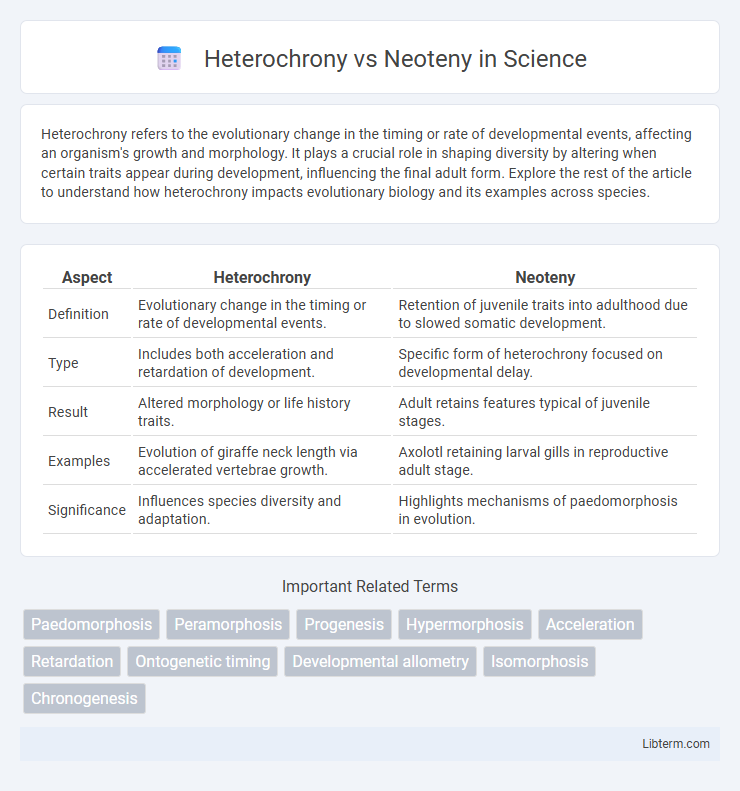Heterochrony refers to the evolutionary change in the timing or rate of developmental events, affecting an organism's growth and morphology. It plays a crucial role in shaping diversity by altering when certain traits appear during development, influencing the final adult form. Explore the rest of the article to understand how heterochrony impacts evolutionary biology and its examples across species.
Table of Comparison
| Aspect | Heterochrony | Neoteny |
|---|---|---|
| Definition | Evolutionary change in the timing or rate of developmental events. | Retention of juvenile traits into adulthood due to slowed somatic development. |
| Type | Includes both acceleration and retardation of development. | Specific form of heterochrony focused on developmental delay. |
| Result | Altered morphology or life history traits. | Adult retains features typical of juvenile stages. |
| Examples | Evolution of giraffe neck length via accelerated vertebrae growth. | Axolotl retaining larval gills in reproductive adult stage. |
| Significance | Influences species diversity and adaptation. | Highlights mechanisms of paedomorphosis in evolution. |
Understanding Heterochrony: Definition and Concepts
Heterochrony refers to evolutionary changes in the timing or rate of developmental events, leading to variations in size and shape among organisms. It encompasses processes such as paedomorphosis and peramorphosis, which alter the onset, offset, or speed of developmental traits. Understanding heterochrony is crucial for studying morphological differences and evolutionary adaptations across species.
What is Neoteny? A Detailed Overview
Neoteny is a form of heterochrony where the developmental process is slowed or delayed, resulting in the retention of juvenile traits in the adult organism. This evolutionary mechanism plays a significant role in species differentiation and adaptation by altering the timing of physiological and morphological development. In humans, neoteny is evident in traits such as a flat face and large brain relative to body size, distinguishing our species from other primates.
Key Differences Between Heterochrony and Neoteny
Heterochrony refers to the broader evolutionary change in the timing or rate of developmental events, influencing an organism's morphology and life history traits, while neoteny specifically describes the retention of juvenile features into adulthood due to slowed somatic development. Heterochrony encompasses various types such as paedomorphosis and peramorphosis, whereas neoteny is a subtype of paedomorphosis characterized distinctively by delayed bodily development relative to reproductive maturity. This key difference highlights heterochrony as an overarching mechanism, with neoteny representing a specific pattern within developmental timing alterations.
Evolutionary Significance of Heterochrony
Heterochrony refers to evolutionary changes in the timing or rate of developmental events, leading to significant morphological diversifications across species. It drives phenotypic variation by altering developmental trajectories, which can result in traits such as neoteny, where juvenile characteristics persist into adulthood. The evolutionary significance of heterochrony lies in its ability to facilitate rapid adaptation and speciation by modulating growth patterns and developmental timing within lineages.
Neoteny in Animal and Human Development
Neoteny in animal and human development refers to the retention of juvenile characteristics into adulthood, influencing physical and behavioral traits. In humans, neoteny is evident in features such as a flatter face, larger brain, and prolonged learning periods, which are associated with enhanced cognitive abilities and social behaviors. This biological phenomenon plays a critical role in evolutionary processes by altering developmental timing and contributing to species adaptation.
Mechanisms Behind Heterochrony and Neoteny
Heterochrony involves changes in the timing or rate of developmental events, influencing organismal morphology and evolution by altering gene expression patterns and growth phases. Neoteny, a subset of heterochrony, specifically refers to the retention of juvenile features into adulthood caused by slowed somatic development while reproductive development proceeds normally. Molecular mechanisms driving these processes include modifications in hormonal regulation, such as thyroid hormone levels, and shifts in developmental gene networks like Hox genes.
Examples of Heterochrony in Nature
Heterochrony, the evolutionary change in the timing of developmental events, manifests in diverse examples such as the prolonged larval stage of the axolotl, which retains juvenile traits into adulthood, demonstrating neoteny. Other instances include the accelerated development of facial features in domesticated dogs compared to their wild ancestors, illustrating predisplacement, a form of heterochrony. These variations highlight how alterations in growth rates and developmental timing drive morphological diversity across species.
Impact of Neoteny on Morphological Traits
Neoteny, a form of heterochrony characterized by the retention of juvenile traits into adulthood, profoundly influences morphological traits by extending the developmental timing of specific features. This delayed maturation results in adult organisms exhibiting characteristics typically seen in their juvenile stages, such as larger head size, flattened faces, and softer skeletal structures. The impact of neoteny on morphology is evident in diverse species, notably in domesticated animals and humans, where it contributes to traits associated with plasticity and adaptability.
Heterochrony vs Neoteny: Comparative Analysis
Heterochrony refers to the evolutionary change in the timing or rate of developmental events, resulting in alterations of size and shape among organisms, while neoteny is a specific type of heterochrony where the retention of juvenile traits occurs into adulthood. Comparative analysis of heterochrony versus neoteny highlights that neoteny emphasizes the delay or slowing of somatic development relative to reproductive maturity, whereas heterochrony encompasses broader shifts including acceleration, retardation, and changes in the onset of developmental stages. Studies in evolutionary biology and developmental genetics show that neoteny can drive evolutionary innovation by preserving youthful characteristics, contrasting with other heterochronic processes that may lead to diverse morphological adaptations.
Future Directions in Heterochrony and Neoteny Research
Future research in heterochrony and neoteny is increasingly leveraging genomic and epigenetic technologies to unravel developmental timing mechanisms at a molecular level. Integrating advanced imaging techniques with computational modeling enables precise quantification and prediction of morphological changes related to heterochronic shifts, facilitating a deeper understanding of evolutionary adaptations. Emphasis on cross-species comparative studies and the exploration of environmental influences on gene expression will drive discoveries in the evolutionary and developmental significance of neoteny.
Heterochrony Infographic

 libterm.com
libterm.com